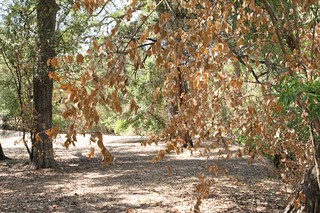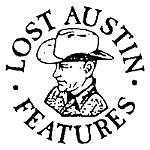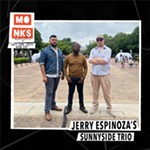Poison in the Park
Plants and trees in Stacy Park began to die after a Parks and Rec volunteer sprayed herbicide
By Jordan Smith, Fri., Sept. 2, 2011

If there's one thing that the neighbors of Stacy Park, in South Austin's Travis Heights, feel they know for sure, it's that Daniel White really hates poison ivy. What the neighbors say they don't know is why the city's Parks and Recreation Department would agree to allow White, as a volunteer, to spray herbicide along the mile-and-a-half-long park and up and down sensitive Blunn Creek – an area that the city is working to restore – without notifying neighbors that the spraying would take place. Now, they say, the park is a mess. Trees are dying, and residents are concerned about the possible effects of the chemicals on the area wildlife, as well as on children and pets. "It's the worst kind of stewardship of watershed and resources," says Jeff Kessel, an environmental engineer who lives in the neighborhood.
White, who used to live near the park, says he can document the injury done to people – many of them children – by the unruly and invasive poison ivy that is endemic along Stacy Park and Blunn Creek, which runs through the park. White conducts 90-minute tours of Austin parks that are overrun by the plant and says he's taken many on the tour – including "all [City] Council staff and other interested parties" – as a way to explain and document the ongoing problems.
In the Nineties, White's dislike for the plant led him to go to the South River City Citizens Neighborhood Association, which includes Travis Heights, to address the problem; he says they weren't interested in hearing about it – and that the neighborhood association is still deaf to the perils posed by the plant. He's also approached PARD on several occasions with "information and opinion on maintenance" in the city's parks, says Kelly Snook, the department's assistant director.
It wasn't until early this year that White's talks with PARD and his dislike of poison ivy coalesced into a plan: White would get a pesticide applicator license from the Texas Department of Agriculture and would then provide chemicals (at no cost to the city) and free labor (as a PARD volunteer) to eradicate the poison ivy, along with a short list of other invasive species (including ligustrum, china berry, and nandina). He wrote a one-page proposal in February, explaining that he would work along the creek from Riverside Drive south to Live Oak Street. "I do not plan on any buffer zone around the creek," White wrote in his proposal. "Operator skill here obviates any requirement for buffer zone as well."
The neighborhood association knew nothing about the arrangement until mid-June, when neighbors say they first noticed White spraying throughout the park. White told neighbors who inquired that he was authorized to be there by PARD. That alarmed many of them, especially after swaths of vegetation in the park began to die. Moreover, some neighbors say that more plants than just those on the "approved" list of species have been damaged – including box elders, cedar elm, and mustang grapes.
Equally disturbing, say some neighbors, have been the responses from PARD. "Their responses are very confusing; they're hearing what we're saying, but they don't want to talk about it," says Kessel. "They say, 'This is a maintenance project, and we don't usually talk to people about maintenance; we just go and do it.'" Had it been a construction or other kind of project – like the ongoing restoration along Blunn Creek – the neighbors would have been notified. According to PARD's Snook, this is the first time the department has ever used a volunteer, without oversight, to spray chemicals in a park. "To put this in the category of maintenance," says Kessel, "it's just bizarre."
There is little doubt that PARD is perpetually underfunded and understaffed; where the department can get help, it often does. Travis Heights neighbors are passionate about Stacy Park and are among the many residents citywide who pitch in to keep city parks clean and maintained. But it's puzzling why PARD would allow a volunteer to spray herbicide without oversight and without notice to the neighbors.
Snook says the partnership with White was a "pilot project," and that while the city has allowed volunteers to spray chemicals in the past, it has always been during group projects and with PARD supervision. White obtained the necessary license and was bonded and insured, she said, so allowing him to do the job as a volunteer is the same as if the department hired a contractor. What else, she asks, "would you anticipate" the city to do to vet White? White was apparently unsupervised at all times – for example, the city never checked that White posted the required signage warning about the spraying. White says he had some "little flags" that he posted but that none of the neighbors paid any attention to them; neighbors claim White never posted the signage as he was directed.
"Because he sprayed with no warning," says neighbor Teresa Griffin, "my concern is not only for the wildlife eating the poison, but for the neighbors as well." For example, neighbors say mustang grapes were sprayed, which they often pick and eat. The situation prompted neighbors to ask PARD for a report on what happened and how the department can create protocols and procedures for using volunteers for these kinds of projects in the future. (White told the Chronicle that he has also sprayed for poison ivy in the BMX section of Duncan Park; PARD's Snook says she was not aware of that and that those actions have never been approved.) The overarching concern isn't about White in particular, say neighbors, but about the department's actions going forward and how it will communicate its activities to neighbors. For example, the city is still in the process of putting together a comprehensive plan for dealing with invasive species, like ligustrum, and should have waited to undertake any spraying until after that plan was complete. "We're not too fixated on Daniel White," says neighbor David Todd, who is an environmental attorney and co-chair of the neighborhood association's Parks, Schools and Environment Committee. The larger question is, "How should a city agency deal with neighbors?"
The city is still in the process of drafting its report, says Snook, with input from the South River City Citizens Neighborhood Association. Griffin says she wrote a list of recommendations for future volunteer efforts – including emergency response plans if something goes wrong.
Snook says the city has done a walk-through of the park with neighbors to determine the extent of the damage and to identify trees that may need to be removed. Some residents worry that the damage has been extensive and will ultimately be too expensive to mitigate. Having volunteers do this kind of work "in the name of the city, we need to be very careful about oversight and good notice," says Todd. Indeed, says Griffin, the neighbors are still interested in working with PARD "and not have [this] be a public spanking. But there has to be an admission that they did things wrong."
[For Daniel N. White's letter regarding this feature, click here.]
Got something to say on the subject? Send a letter to the editor.









